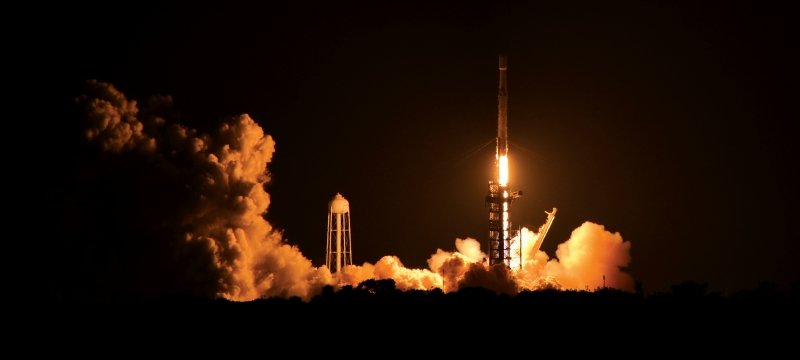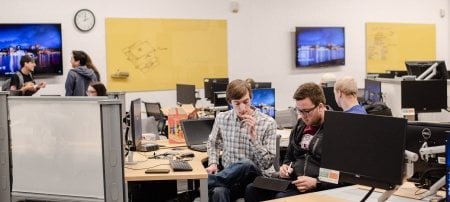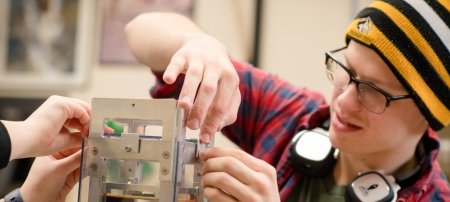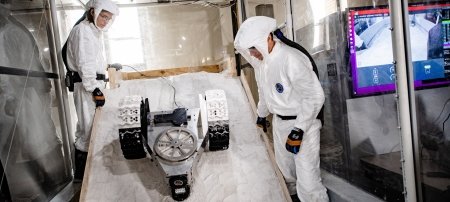At 2:30 a.m. June 25, 2019, Michigan Tech’s student-built Oculus-ASR nanosatellite rode the SpaceX Falcon Heavy from Cape Canaveral Pad 39A into orbit. It’s a University first, but by no means the last.
The new space race is driven by commercialization, tech miniaturization, and lower costs. Space is easier and cheaper to reach than ever before. However, there’s still nothing simple about building a satellite.
At 90-plus current members with more than 800 alumni, one satellite in orbit, and two more missions in the works, Michigan Tech’s Aerospace Enterprise team has worked through the challenges and experienced the triumphs. It’s one of the largest and most successful teams in Michigan Tech’s 20-year Enterprise Program. Started at the request of students roughly 18 years ago, it’s also one of the oldest. Nearly two decades of training in small satellite development, from concept to launch-ready, has positioned students among the next generation of aerospace engineering leaders. Here’s how they got their first nanosatellite, Oculus-ASR, into space last summer and their plans for two new missions, Auris and Stratus.
“We have an established presence in the field,” says current team program manager Marcello Guadagno. “You’re working on something that until very recently was in the domain of large corporations and governments. You get to see your work in space; people don’t get to see that too often.”
Not Your Parent's Sputnik
In the system concept and critical design review phase, research is paramount. The initial step, deciding what you want your satellite to do and how that aligns with a funding agency’s mission can take months, as can diving deep into what’s worked and what hasn’t. Be it a military branch, National Aeronautics and Space Agency (NASA), or private entity, the team is tasked with creating a compliant proposal that meets all criteria. In the assembly, integration and test phase the spacecraft comes together, employing both off-the-shelf and custom components created in-house. In the environmental test phase, the satellite is shipped for bake out, thermal cycling and vacuum, vibration testing—a violent process commonly referred to as shake-and-bake that simulates the rigors of launch and orbit in the space environment. These steps all lead to the coveted launch and missions operations phase.
Read more about how the nuts and bolts of the Aerospace Enterprise missions on the university research blog Unscripted.
Mission: Oculus-ASR
Oculus-ASR is fittingly named for its role to help the US Department of Defense (DoD) improve its vision when monitoring satellites; the ASR stands for attitude and shape recognition. Its mission is one of, if not the first, dedicated to providing a cooperative target for ground observatories as a means to help telescopes gauge imaging capabilities. Six months into its nine-month mission, the 150-pound satellite now orbits in Low Earth Orbit (LEO is 99 to 1,200 miles above the planet’s surface) changing shape and performing complex maneuvers to present an ever-shifting target for ground telescopes.
The mission kicked into high gear with winning the University Nanosat 6 competition in 2011. This netted the team the Air Force Office of Scientific Research (AFOSR) contract to launch Oculus under the guidance of the University Nanosatellite Program (UNP) for the Air Force Research Laboratory (AFRL). 2017 graduate Jesse Olson, who started building rockets when he was 12 years old and served as the chief engineer for Oculus as a student, now heads the UNP.
“I knew I was going to join the team before I even got to Michigan Tech because I knew I wanted to do aerospace. When I came into the process, the whole satellite was completely designed. A lot of the people that designed it had already graduated,” Olson says. “There was a learning curve to catch up. Debugging, fixing, trying to understand why designers made the choices they did.
“That’s one of the biggest challenges across all UNP and university projects,” he notes. “Teams working through multi-year projects have to come up with ways to combat that through documentation and training.”
Olson now guides a new generation of Aerospace Enterprise students through the very program that resulted in the successful Oculus launch. In its 20-year history UNP has worked with 38 universities and has 15 satellites and seven launches under its belt. Olson is currently working with 12 universities on 14 missions.
Working on the Oculus project as an undergrad showed Olson the inherent give-and-take of the effective mentoring techniques he uses today. “I’m always getting advice from other people. This is not a one-man show,” Olson says. “And while I don’t see him as often as I used to, I still regard Dr. Brad King as a mentor.”
King, the Richard and Elizabeth Henes Professor (Space Systems), has been the Aerospace Enterprise team advisor since the group formed. Over the years students have made their mark in the industry—and also left their mark in laboratory work spaces. King shows a scribbled piece of paper that reads, ‘Oculus means family—and that means nobody goes home.’
“That perfectly captures the perseverance of the team,” King says. There were many moments when the end-goal seemed doubtful. “The number of near-failures are too numerous to list. I can’t count how many times we were on the brink of missing a key deadline, or we were out of funds with no clear path forward, or we damaged an irreplaceable component during testing. Somehow they always found an alternative path.”
The hardest decisions involved descoping critical components or functions to reduce budget or meet a government deadline. “These decisions involved abandoning something that part of the team spent years developing, in order to ensure success of the core mission,” says King. “In the end, all of the decisions proved to be justified and correct.”
Launch: Oculus-ASR
In spring 2019, SpaceX announced a June 24 launch window beginning at 11:30 p.m. for the DoD Space Test Program-2 (STP- 2) mission, managed by the US Air Force Space and Missile Systems Center. The mission would deliver 24 satellites to space; with Oculus first off the rocket. Nearly 40 alumni and their advisor headed to Cape Canaveral.
Delayed by a ground hydraulics system issue, liftoff took place three hours into the four-hour launch window.
"When the launch date finally came, current and former students traveled across the country to be together again and watch their satellite head off to do its job."
“So much energy and anticipation, and now we had to cool our heels for a few hours,” says King, who watched with his son from a balcony at the Operations Support Building II located next to the Space Center’s iconic Vehicle Assembly Building.
Roughly five miles away, about 40 Aerospace alumni played the waiting game at the Banana Creek Launch Viewing Area, situated on a lagoon overlooking the launch site. The live broadcast announced 30 seconds. Then 15.
“Ten, nine, eight, seven, six,” alumni counted down together, “five, four, three, two, one, zero … Wooooo!”
Falcon Heavy blasted into the sky. The lagoon gleamed, briefly illuminated brighter than day then returning to darkness as the flash of the rocket flare was swallowed in the low horizon of billowing steam rising from the launch pad.
Their eyes were on Oculus.
“It’s difficult to describe,” says Guadagno. His phone video captures the elation of the moment—bright voices in the dark—as the rocket carrying a milestone accomplishment for so many steadily ascends toward the stratosphere, encouraged every step of the way: “Here we go!” “Yes!” “Go, baby, go, baby, go!” There was applause as the boosters separated and fell to Earth accompanied by four sonic booms.
Back at the Space Center, King watched the video livestream. Oculus was scheduled for release 13 minutes into the mission. Seconds before deployment the video stream cut out as the rocket passed beyond line-of-sight from ground control. Another antenna picked up the feed a few minutes later.
“When the video stream came back, Oculus was gone!” King says. “While it was frustrating to miss seeing her release, it was striking to notice the empty spot where she used to be located.”
The celebration, including a group photo and high-fives, continued at Banana Creek.
“It was so much fun!” says 2018 graduate Sarah Wade, an electrical engineer with Space Dynamics Laboratory in Utah. The launch wasn’t her first Oculus-induced adrenaline rush.
Several years earlier, Wade, a double major in electrical and computer engineering was among the small group who worked tirelessly to get the nanosatellite shipshape when the call for environmental testing at Kirtland Air Force Base came unexpectedly in summer 2017: After six years of development and hundreds of undergraduate R&D hours, it was go time.
The deadline: four weeks to reassemble, test, and ship the nanosatellite. Olson, who would go out to Kirtland himself not long after, remembers the pressure as well as the satisfaction of accomplishing the goal. The team was short on members—most had already left campus for the summer—but powered through in one intense week.
“There were six of us. It was like six 16-hour days in a row. We made it—got it on the truck in time!” Olson says.
“Even though we do beat the satellites up (at AFRL), these are very controlled environments, conducted with the proper equipment and trained personnel,” says Olson, adding that the hurry-up-and-wait syndrome continues with securing a launch vehicle. “We were launch-ready for several months. Oculus was isolated from the world, first in a clean room, then in a shipping container under a nitrogen purge.”
"The Aerospace Enterprise has helped me identify what I want to do in my career, and I am ever grateful for the opportunity to work on such a team. Plus, we get to put stuff in space!"
Olson is among those who has been keeping an eye on Oculus since the launch. “We had successful sphere deployment, and the ground telescopes collected some light curves as Oculus flew overhead,” he says. Data coming in continues to indicate that Oculus is doing its job. “So far everything seems to be functioning as expected.”

Blastoff! Michigan Tech's Oculus-ASR Satellite Launches at Cape Canaveral
Join Huskies from Michigan Technological University's Aerospace Enterprise team as they cheer on the June 25, 2019 launch of the nanosatellite they built. Fun phone video of the countdown and launch by former Aerospace Enterprise Program Manager and Michigan Tech graduate student Marcello Guadagno.
Mission: Auris
The microsatellite Auris is one of 10 in Phase A of the four-phase AFRL UNP process. Huskies have already cleared one hurdle in this preliminary phase: the system concept review to help the team develop mission objectives and goals.
Stratus, Auris, and Oculus are all nanosatellites. But at 10-by-20-by-30 centimeters with a preliminary estimated mass of 15 kilograms, Auris is a much smaller satellite than Oculus-ASR, whose dimensions have been compared to a mini-fridge. Auris, Latin for “The Ear,” will monitor communications emissions from geostationary satellites. Listening, in an increasingly congested space environment, will allow researchers to spatially map the power radiated from high-frequency emissions of spacecraft in high orbit to determine how it impacts ground receivers.
Olson and a team of fellow engineers from AFRL came to campus in December for preliminary design review. Additional reviewers participated remotely in the eight-to- 10-hour series of team presentations.
“A satellite has value for the research and science it can do; it needs to be compliant [with the requirements for its mission]. The feedback from formal design reviews helps guide students,” Olson says.
Aerospace Enterprise team chief engineer Matthew Sietsema, a double major in electrical and computer engineering, says the group was looking forward to demonstrating the maturity of the project and the progress made since the last review.
Mission: Stratus
Stratus, named for its cloud-imaging mission, is funded through NASA’s Undergraduate Student Instrument Program and the CubeSat Launch Initiative. Sietsema says there are no specifics on a timeline yet, but that Stratus will be launched from the International Space Station.
The 10-by-10-by-30 centimeter and 4.4 kilogram CubeSat (named for its cube like configuration) is a three-axis-stabilized thermal infrared telescope designed to provide a low-cost solution to imaging atmospheric clouds. Cloud fraction, top wind, and top height data is used to reconcile climate models. If all goes as planned, more Stratus spacecraft could be deployed to gather hyper-local weather data.
The CubeSat underwent and passed its critical design review by a NASA-Goddard Spaceflight Center team in December 2018. “While we suffered a few nicks and dings from the event (as is common during CDR),” King wrote in an Aerospace blog, “we passed and can now move on to system integration in preparation for an upcoming launch.”
Stratus is currently on track for completion in December 2020. Its payload subteam has integrated with the software subteam; full satellite functionality tests are underway in the clean room.
Sietsema interned as a multidisciplinary systems engineering intern at Space Dynamics Laboratory in Logan, Utah in summer 2019. “My success in that position can be wholly attributed to my work with the Enterprise. The Aerospace Enterprise has not only shaped the form of my future career, it is the foundation upon which it will be built,” he says. “Working as the chief engineer on both Stratus and Auris has given me a unique insight into spacecraft design, large-scale collaborative projects, and the importance of systems engineering as a tool to structure complex systems. When I first joined the Enterprise, I had only a vague idea what each of those are; now, I look forward to a career dealing exclusively in those areas.”
Launch: Enterprise for Student Success
There are a lot of moving parts to business ventures as well as satellites. Like all Enterprise teams, Aerospace Enterprise operates as a real business.
“During the early years I played an active role in creating our design processes, management structure, and overall culture,” says long-time team advisor King. “Working together with students, and also mentors from AFRL and NASA, we created a systems engineering infrastructure that’s become a skeleton for all of our design projects.”
The system defines and tracks requirements. It gives team leaders templates to manage the schedule and budget of a large team. It includes a self-sustaining leadership and management hierarchy.
“With this system in place the Aerospace Enterprise is now run entirely by the students,” says King. Current leaders mentor their successors, providing year-to-year continuity. A peer-evaluation system provides feedback and promotes advancement within the team and King says the Enterprise has taken on a life of its own. So much so that his role is now more of an outside evaluator, observing the team’s activities and trying to forecast upcoming problems that perhaps are not on their radar.
“The students have created an institution that is resilient,” King says, “and can endure the inevitable personnel changes of a school environment while still tackling and solving major engineering challenges.”
As the Aerospace Enterprise’s software team leader Dante Paglia puts it: “All of us joined not knowing how to write software for a satellite. It’s not taught in classes. You get to say your code is in space. Not every undergrad can say that.”
With two more spacecraft in process and ever-expanding opportunities on the horizon, the Aerospace Enterprise team continues to design, build, and launch both satellites and careers. The thrill of the first success remains and Olson says the coolest part of his job so far was watching Oculus launch. “That was incredible. The Falcon Heavy is currently the most powerful operational rocket in the world. Seeing it launch, feeling it, was all around an amazing experience.”
Michigan Technological University is an R1 public research university founded in 1885 in Houghton, and is home to nearly 7,500 students from more than 60 countries around the world. Consistently ranked among the best universities in the country for return on investment, Michigan's flagship technological university offers more than 185 undergraduate and graduate degree programs in science and technology, engineering, computing, forestry, business, health professions, humanities, mathematics, social sciences, and the arts. The rural campus is situated just miles from Lake Superior in Michigan's Upper Peninsula, offering year-round opportunities for outdoor adventure.









